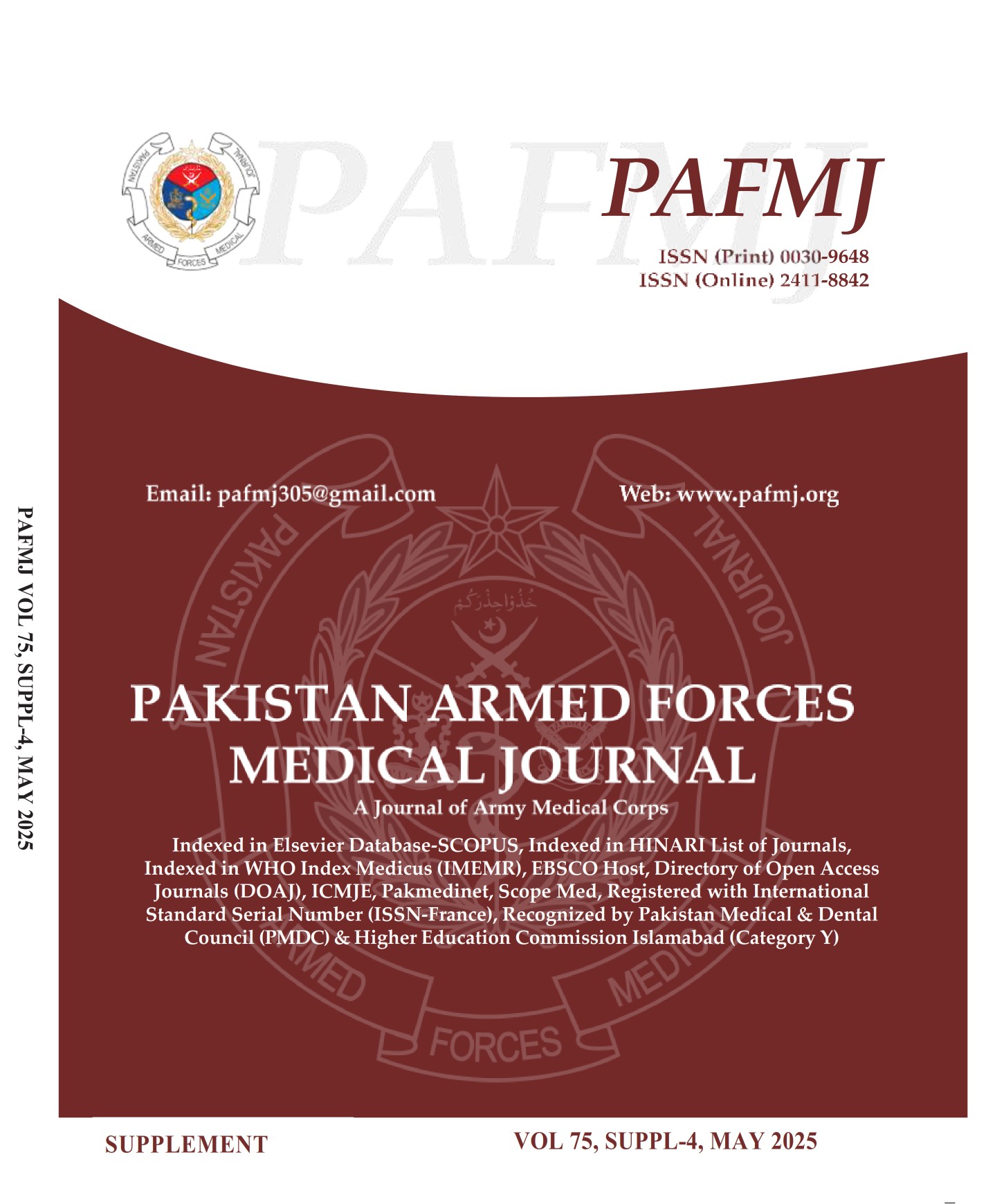The Effectiveness of Different Volumes of Articaine for Inferior Alveolar Nerve Block for Mandibular Molar Teeth with Symptomatic Irreversible Pulpitis
DOI:
https://doi.org/10.51253/pafmj.v75iSUPPL-4.6100Keywords:
Inferior alveolar nerve block, Local Anaesthesia, Root canal treatmentAbstract
Objective: To compare the efficacy of 3.6ml Vs 1.8ml articaine concentrations for lower alveolar nerve blocks with symptomatic irreversible pulpitis.
Study Design: Quasi experimental study
Place and Duration of Study: Operative Dentistry Department, Armed Forces Institute of Dentistry, Rawalpindi Pakistan, from Aug 2017 to Feb 2018.
Methodology: Five hundred Patients with symptomatic irreversible pulpitis were divided into 02 Equal groups A & B, 250 in each Group. Sample size was calculated by WHO calculator. All patients were asked to score their pain using a visual analogue pain scale (VAS). Then a standard Inferior Alveolar Nerve Block with a side-load cartridge device was administered. Group A was treated with 3.6ml articaine and group B was treated by 1.8ml of same solution. Patients were asked to rate their discomfort felt during the procedure. No or mild discomfort was considered as a success while serious or extreme pain was considered anesthesiological failure.
Results: In Group A, IANB was found to be effective in 92% of the subject (n=230) while in Group B, IANB was effective in 72% of the subjects (n=180). The difference in effectiveness of IANB between the 02 groups was statistically significant (p<0.001) where 3.6 ml of articaine was found to be statistically more effective than 1.8 ml of articaine
Conclusion: 3.6 ml volume of articaine was better as compared to 1.8ml volume of same solution for treating patients with acute irreversible pulpitis.
Downloads
References
Nabeshima CK, Caballero-Flores H, Cai S. Bacterial removal promoted by 2 single-file systems: Wave One and One Shape. J Endod 2014; 40(12): 1995–8.
Pak JG, White SN. Pain prevalence and severity before, during, and after root canal treatment: a systematic review. J Endod 2011; 37(4): 429–38.
Shahi S, Mokhtari H, Rahimi S. Effect of premedication with ibuprofen and dexamethasone on success rate of inferior alveolar nerve block for teeth with asymptomatic irreversible pulpitis: a randomized clinical trial. J Endod 2013; 39(2): 160–2.
Ogle OE, Mahjoubi G. Local anesthesia: agents, techniques, and complications. Dent Clin North Am 2012; 56(1): 133–48.
Schellenberg J, Drum M, Reader A. Effect of buffered 4% lidocaine on the success of the inferior alveolar nerve block in patients with symptomatic irreversible pulpitis: a prospective, randomized, double-blind study. J Endod 2015; 41(6): 791–6.
Parirokh M, V Abbott P. Various strategies for pain-free root canal treatment. Iran Endod J 2014; 9(1): 1–14.
Tortamano IP, Siviero M, Lee S. Onset and duration period of pulpal anesthesia of articaine and lidocaine in inferior alveolar nerve block. Braz Dent J 2013; 24(4): 371–4.
Silva SA, Horliana AC, Pannuti CM, Braz-Silva PH, Bispo CG, Buscariolo IA, Rocha RG, Tortamano IP. Comparative evaluation of anesthetic efficacy of 1.8 mL and 3.6 mL of articaine in irreversible pulpitis of the mandibular molar: A randomized clinical trial. PloS one. 2019; 14(7): e219536-8
Aggarwal V, Singla M, Miglani S. Comparative evaluation of 1.8 mL and 3.6 mL of 2% lidocaine with 1:200,000 epinephrine for inferior alveolar nerve block in patients with irreversible pulpitis: a prospective, randomized single-blind study. J Endod 2012; 38(6): 753–6.
Fowler S, Reader A. Is a volume of 3.6 mL better than 1.8 mL for inferior alveolar nerve blocks in patients with symptomatic irreversible pulpitis? J Endod 2013; 39(8): 970–2.
Abazarpoor R, Parirokh M, Nakhaee N, Paul V. Abbott PV. A Comparison of different volumes of articaine for inferior alveolar nerve block for molar teeth with symptomatic irreversible pulpitis. J Endod 2015; 41(9): 1408–11.
Meechan JG. Infiltration anesthesia in the mandible. Dent Clin North Am 2010; 54(4): 621-9.
McLean C, Reader A, Beck M, Meryers WJ. An evaluation of 4% prilocaine and 3% mepivacaine compared with 2% lidocaine (1:100,000 epinephrine) for inferior alveolar nerve block. J Endod 1993; 19(3): 146-50.
Hargreaves KM, Keiser K. Local anesthetic failure in endodontics. Endod Top 2002; 1(1): 26-39.
Aggarwal V, Singla M, Miglani S, Kohli S. Comparative evaluation of mental incisal nerve block, inferior alveolar nerve block, and their combination on the anesthetic success rate in symptomatic mandibular premolars: A Randomized double-blind clinical trial. J Endod 2016; 42(6): 843-5.
Nuzum FM, Drum M, Nusstein J, Reader A, Beck M. Anesthetic efficacy of articaine for combination labial plus lingual infiltrations versus labial infiltration in the mandibular lateral incisor. J Endod 2010; 36(6): 952-6.
Kanaa MD, Whitworth JM, Corbett IP, Meechan JG. Articaine and lidocaine mandibular buccal infiltration anesthesia: A prospective randomized double-blind cross-over study. J Endod 2006; 32(4): 296-8.
Corbett IP, Kanaa MD, Whitworth JM, Meechan JG. Articaine infiltration for anesthesia of mandibular first molars. J Endod 2008; 34(5): 514-8.
Poorni S, Veniashok B, Senthilkumar AD, Indira R, Ramachandran S. Anesthetic efficacy of four percent articaine for pulpal anesthesia by using inferior alveolar nerve block and buccal infiltration techniques in patients with irreversible pulpitis: A prospective randomized double-blind clinical trial. J Endod 2011; 37(12): 1603-7.
Monteiro MR, Groppo FC, Haiter-Neto F, Volpato MC, Almeida JF. 4% articaine buccal infiltration versus 2% lidocaine inferior alveolar nerve block for emergency root canal treatment in mandibular molars with irreversible pulpits: A randomized clinical study. Int Endod J 2015; 48(2): 145-52
Downloads
Published
Issue
Section
License
Copyright (c) 2025 Waqar Ahmad Khan, Saqiba Yaseen, Afshan Bibi, Mehmood Ahmed Rana, Asma Munir Munir, Noureen Malik

This work is licensed under a Creative Commons Attribution-NonCommercial 4.0 International License.















